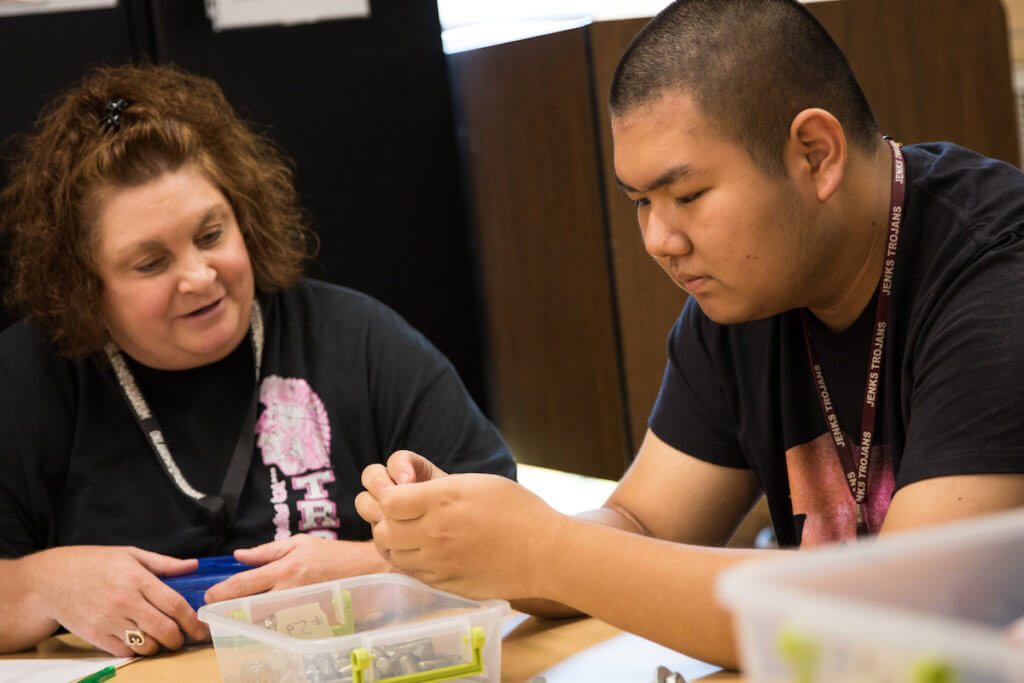

(Editor’s note: This story was authored by Jennifer Palmer of Oklahoma Watch and appears here in accordance with the non-profit journalism organization’s republishing terms.)
Special education teachers have become so scarce that districts face fierce competition to find and keep good candidates. They sometimes leave open positions unfilled.
That’s why, late one night last month, Ponca City Public Schools Superintendent Shelley Arrott sprang into action when she heard the distinctive ding of her cell phone. The alert meant a job application had been submitted online to the district. She scrambled to arrange an interview the next morning for the applicant.
The district hired Melissa Parks, who is certified in special education, on the spot. Parks has since received at least seven other job offers. Now, Arrott said, the focus is on keeping Parks and others like her.
“I can’t reduce their class size. I can’t pay them more,” Arrott said. “But I can appreciate them and make them feel valued, so that’s our big push.”
Oklahoma schools started the school year with more than 500 teaching vacancies, but special education is the most difficult to fill, according to a recent survey of 300 districts by the Oklahoma State School Boards Association. Some districts report special education teacher vacancies year after year.
The shortage of special education teachers is a nationwide problem. It is likely compounded in Oklahoma by the state’s comparatively low teacher salaries, although state law requires that special education teachers receive a salary of 5 percent more than general education teachers. Forty-six states, including Oklahoma, reported shortages in special education for the 2017-2018 school year; math and science are also hard-to-staff areas.
To fill teaching vacancies, Oklahoma schools are increasingly relying on emergency certified teachers, and as of August a record 1,400 had been approved. But by law, special education slots aren’t eligible.
For some school districts, a solution is larger class sizes. That means more students in regular classrooms, where special education students learn alongside other students, and larger self-contained classrooms, where students with disabilities receive specialized interventions and support.
Districts say hiring paraprofessionals helps special education teachers manage more students. Paraprofessionals provide instructional support, such as tutoring and classroom management; paraprofessional jobs don’t require a degree and pay around $8 an hour.
High turnover is driving the special-education teacher shortage. Special education teachers tend to leave the classroom at higher rates than general education teachers, and they burn out quicker, research has shown. Coupled with the normal teaching demands is a grueling amount of paperwork and meetings required by federal law.
But the shortage is a pipeline issue, too. Federal data show students graduating with teaching credentials in areas like early childhood and elementary education far outnumber those credentialed to teach students with disabilities. The University of Oklahoma, for instance, graduated six special education teachers in 2015-2016, compared to 69 in elementary education. Keeping those graduates in Oklahoma is an even bigger issue: More than half of OU’s spring teaching graduates accepted jobs out of state this year.
‘Whether to do the paperwork or teach the kids’

Special education teachers work with students with disabilities, which include autism, emotional disturbances, traumatic brain injuries, learning disabilities, and hearing and visual impairments. Sixteen percent of Oklahoma students, or more than 109,000, needed special education services in 2016-2017, an increase of 10,000 students over 2011-2012, according to the state Education Department.
Federal law requires each student with disabilities to be on an individualized education program, which has improved services for students but is contributing to teacher burnout, says Eleanor Goetzinger, a behavior specialist and special education teacher at Oklahoma City Public Schools. Parents are an integral part of the program and meet with teachers regularly for updates on their child’s progress.
Goetzinger said she always feels like a juggler with three balls in the air: teaching, a vast amount of paperwork, and a lot of meetings. “You’re trying to figure out whether to do the paperwork or teach the kids,” she said.
She has also seen an increase in the number of students with mental illness who are at times dangerous to themselves or others — an issue she wrote about in 2016. Goetzinger herself was assaulted by a third-grader in 2013. And while taking the boy to the principal’s office, she was pushed into a wall by the boy’s father. She suffered a concussion, but returned to the classroom. Even traditionally trained, special education teachers are often unprepared for these students.
Most of the time, special education students are educated within a regular classroom, with the special education teacher providing support.
Having a well-trained special education teacher on staff is an invaluable asset to the school, said Roxie Terry, superintendent of Waurika Public Schools. The district of 400 students has struggled to fill teaching vacancies, in part because the community is just a few miles north of Texas, whose teacher salaries are significantly higher.
“A special ed teacher is a fantastic tool for the teachers. It’s not just the students that improve. Your entire faculty and student body gets better,” Terry said. A special education teacher can recommend specific teaching methods to colleagues that help certain students and improve overall teaching.
Waurika’s high school was without a special education teacher for several years until the current teacher was hired in 2014. Terry said students now receive more supplemental instruction and individualized attention.
Some small, rural districts don’t employ a special education teacher, data show. If they have students with disabilities, those districts can either share services with another district or provide them through a special education co-op.
Fewer people and resources raise the risk that students won’t receive the best quality education, said Katherine Bishop, vice president of the Oklahoma Education Association, who taught special education for 22 years.
“Anytime you cut back … that’s less support you’re able to give,” she said.
‘Because of the pay’

Jenks Public Schools, just south of Tulsa, typically maintains a strong applicant pool but has for years struggled with vacancies in special education. This year, all positions were filled due to the district’s beefed-up recruitment efforts and encouragement of other teachers to pursue certification in special education, said district spokesman Rob Loeber.
The state Department of Education offers a “boot camp” to fast-track educators willing to pursue a master’s degree or certification in special education. This alternative route was approved by the state Legislature in 2013.
Participants receive 120 hours of training in special education online over six Saturdays and perform 30 hours of field experience, after which they can apply for a provisional certificate. They can start working with a provisional certificate, and it can be renewed twice as long as they complete six hours of college coursework per year. By the end of the third year, the candidate must meet the criteria for a standard certificate.
In 2016-2017, the Education Department began providing grant money to reimburse districts the cost of special education training and certification, one of several initiatives recommended by a teacher shortage task force.
At the University of Oklahoma, initiatives include a debt-free teachers program, which forgives student loans for teachers who go into high-need areas.
Arrott, the Ponca City superintendent, said the lack of external applicants spurred her to recruit from within — by approaching classroom teachers and encouraging them to obtain certification in special education. So far, three have been certified. The district also hired a retired teacher with special education certification to return to the classroom part-time.
More traditional recruiting efforts, such as attending out-of-state job fairs, have proven to be a waste of time, she said.
“Out-of-state candidates aren’t interested because of the pay,” she said.
Moore Public Schools started this school year with at least eight unfilled special education positions. The district is relying on paraprofessionals and teaching assistants in many schools, and Superintendent Robert Romines says it’s not ideal.
“A certified special education teacher who has been trained to work with these children, that’s key. That’s what we want,” he said. “But if they’re not out there, we have to look at different ways to staff those classrooms.”




















